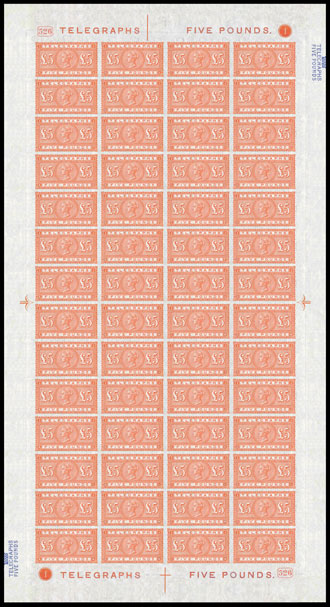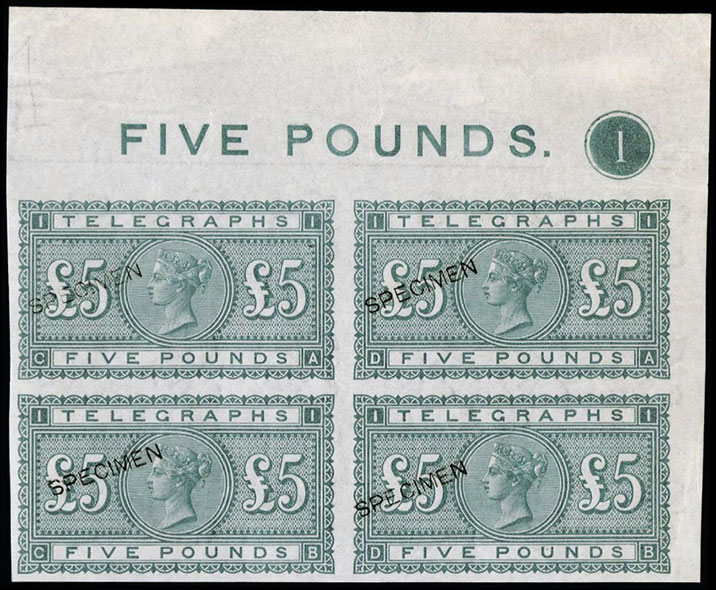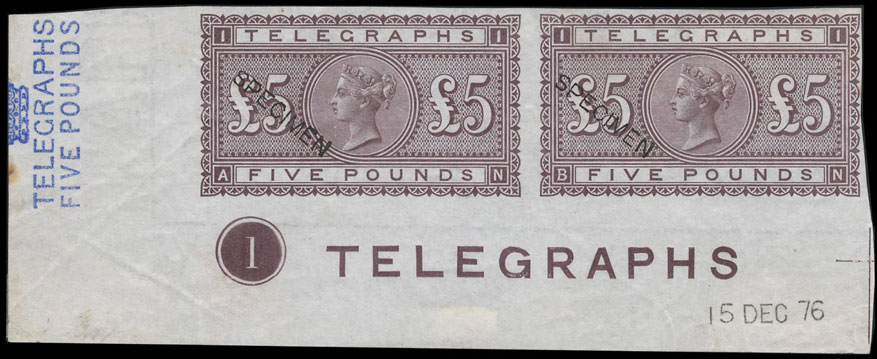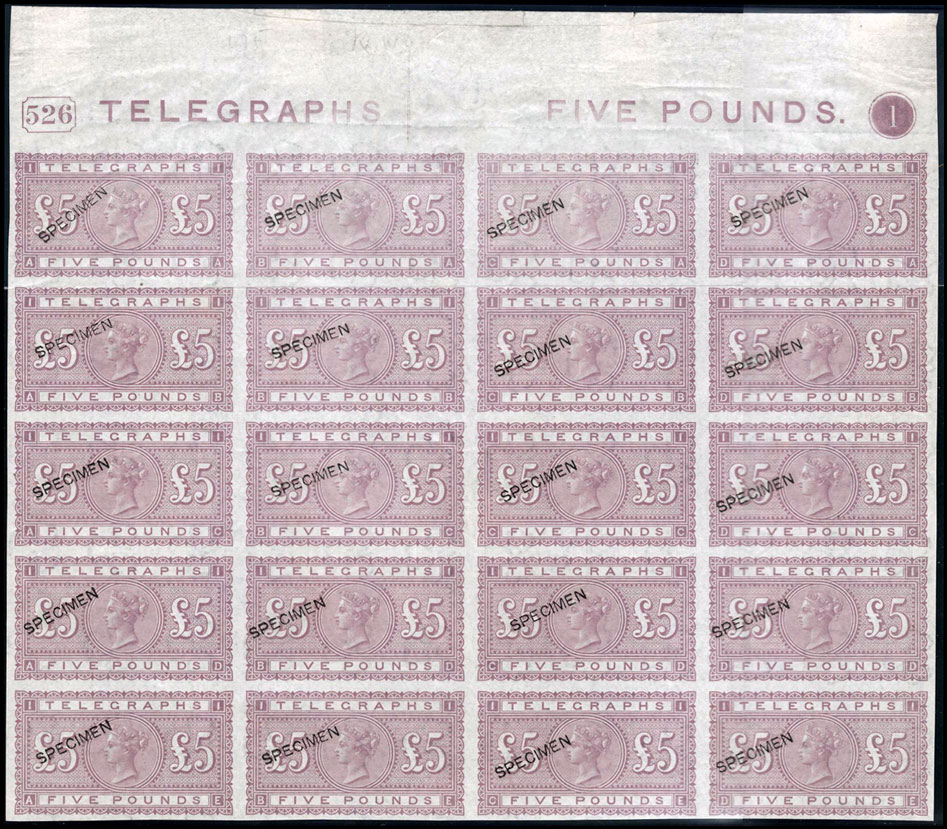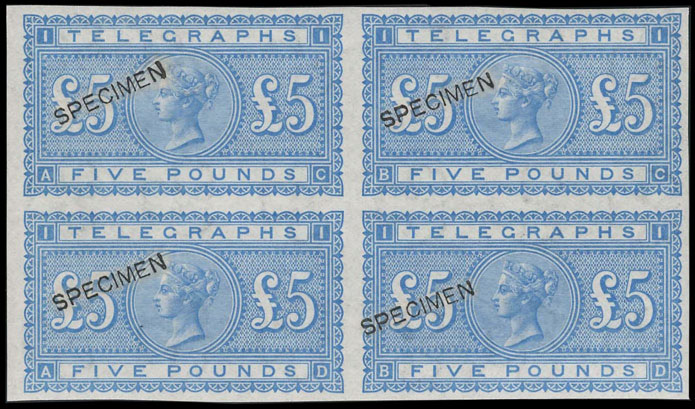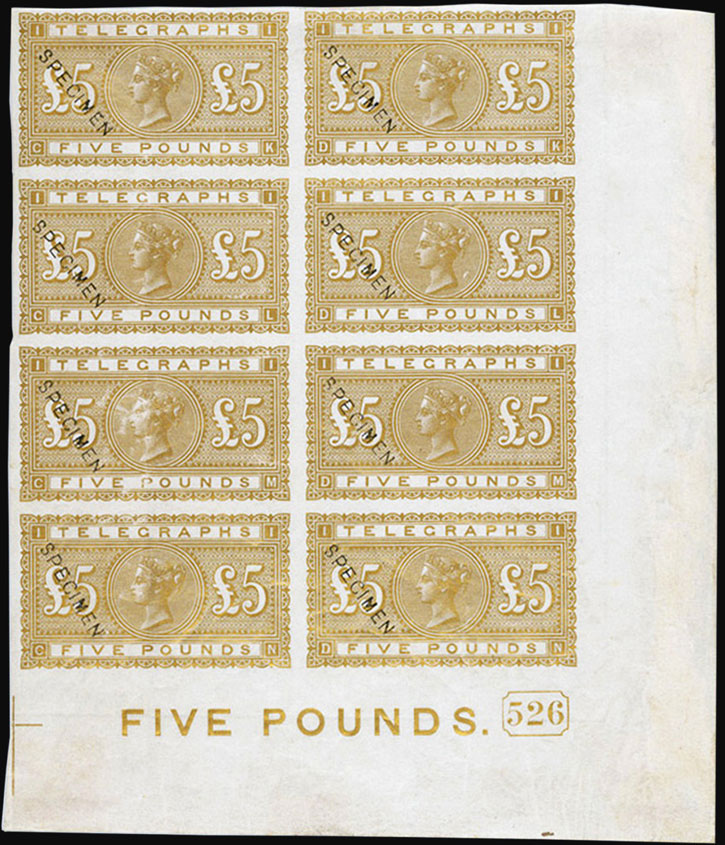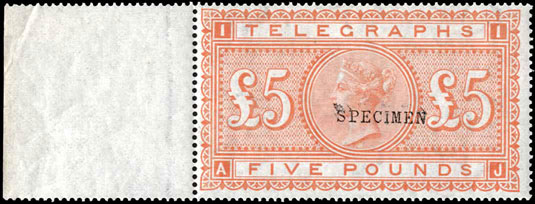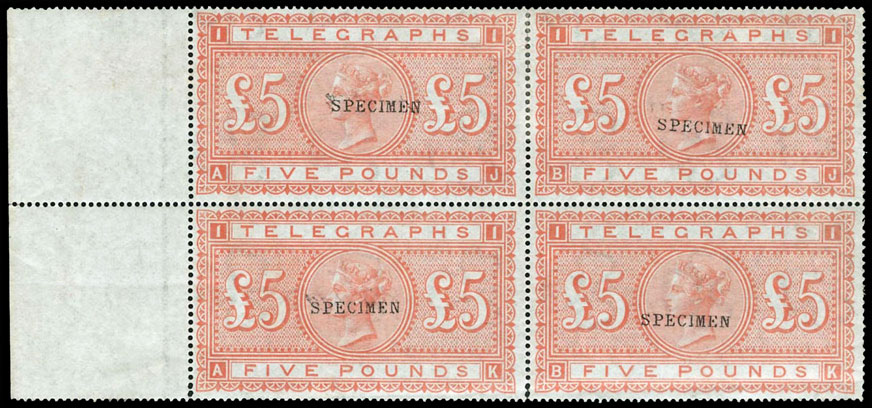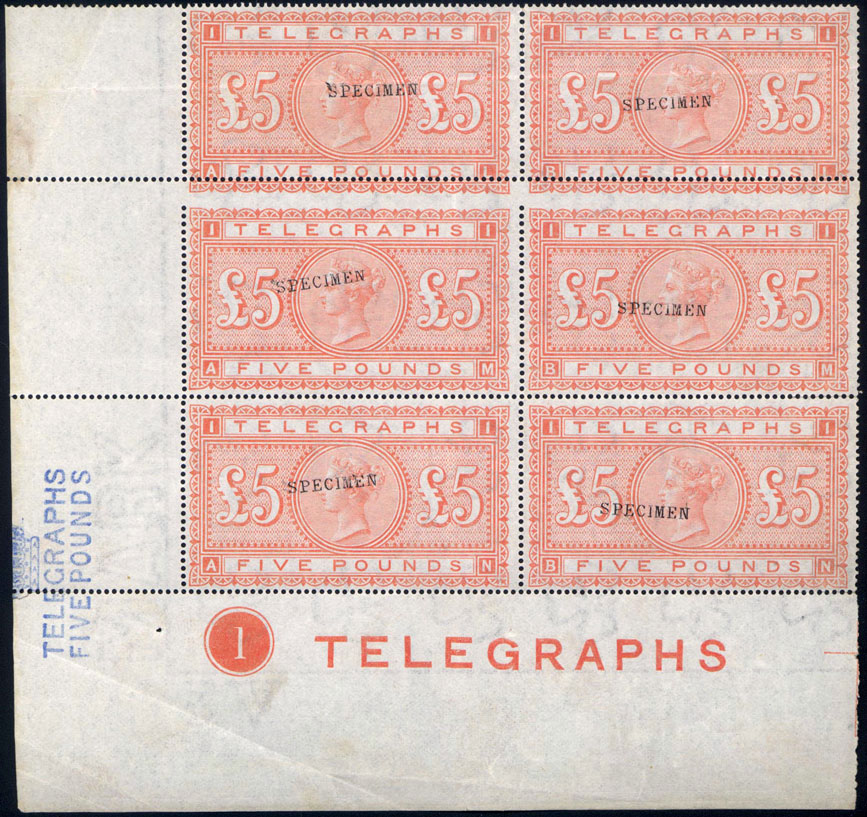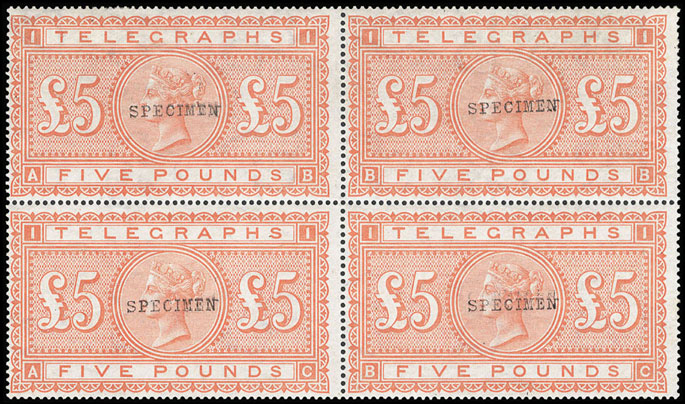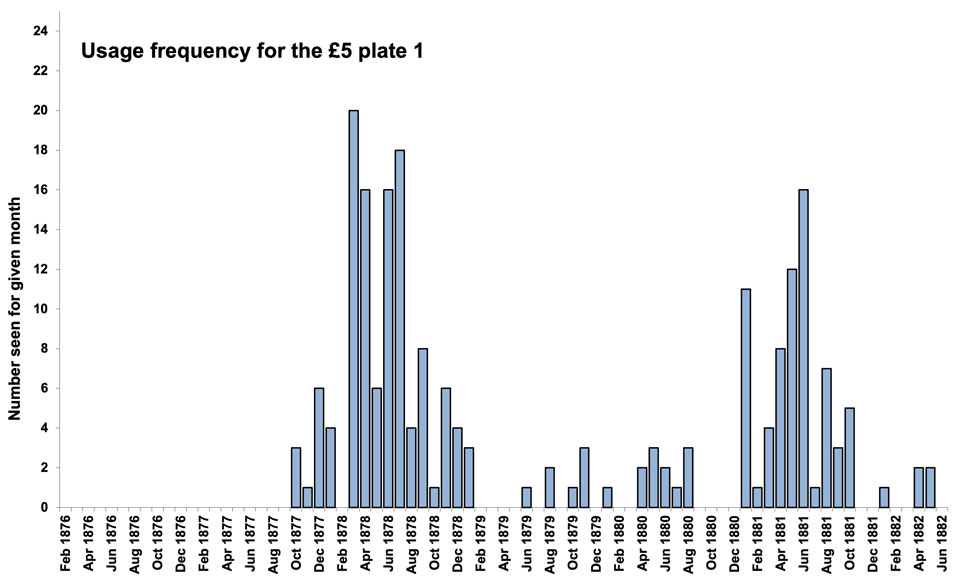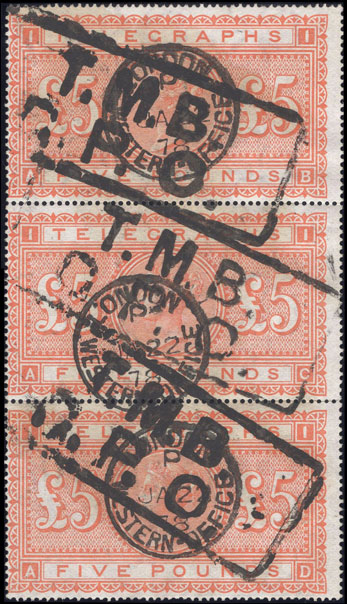1 Essays
2 Die Proofs
3 Sheet Layout
4 Plate Proofs
5 Paper
6 Colour Trials
7 Imprimaturs
8 Colour Standards
9 Specimens
10 Issued Stamps
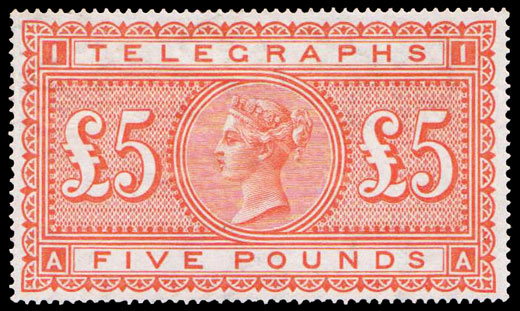
Date: 1 Mar 1877
Plates: 1
Printer: De La Rue
Watermark: Shamrock (sideways-inverted)
Perforation: 15×15½
Soon after the first issue of telegraph stamps on 1 Feb 1876 there was a demand for more values. On 24 Mar 1876 the Postmaster General approved six new values: 4d, 6d, 3s, 10s, £1, and £5.
It had been decided that telegraph stamps of the same value as postage stamps would be printed in the same colour and on the same paper as the corresponding postage stamps. However, at the time there was no corresponding £5 postage stamp (first issued in 1882), so Shamrock paper was chosen and trials were produced in seven different colours.
For the £5 a sheet was printed in gold in addition to the six fugitive inks used for the other values, but the high cost of gold ink ruled it out and pale ultramarine (blue) was selected instead. At the last minute it was noticed that this made the stamp too similar to the £5 Probate Court stamp and the colour was changed to vermilion (orange).
Only one plate was prepared and registered.
Essays
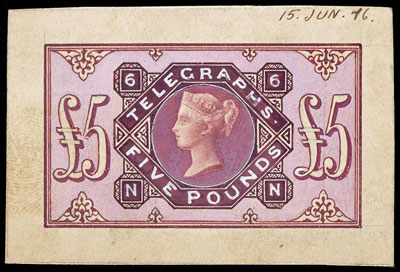
Ex De La Rue archives — courtesy of Robson Lowe.
Several essays were prepared by De La Rue for the second issue, including designs lettered ‘C’ to ‘H’ and dated 21 Apr 76. Two further designs for the £5 are dated “15 JUN 76”. Approved designs of all six values were submitted later but are undated. All except the one illustrated above are now in the Royal Philatelic Collection.
| F | £5 | 66 | NN | blue |
| I | £5 | 66 | NN | orange |
| — | £5 | 66 | NN | reddish purple (illustrated) |
| — | £5 | 66 | NN | reddish purple, approved design |
For more details on second issue essays click here.
Die Proofs
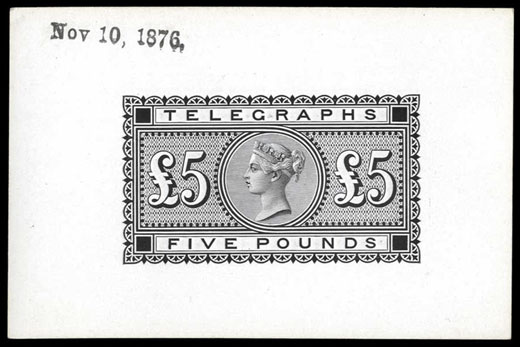
To see more £5 Die Proofs click here.
| Nov 8, 1876 | — | — | Dark background to Queen’s head | 0 + 1 |
| Nov 8, 1876 | — | — | — | 2 |
| Nov 8, 1876 | — | — | “Postage” in pencil | 1 |
| Nov 9, 1876 | — | — | — | 4 + 2 |
| Nov 10, 1876 | — | — | — | 7 + 1 |
| Nov 14, 1876 | — | — | — | 4 + 2 |
| Nov 15, 1876 | — | — | — | 9 + 1 |
| Nov 16, 1876 | — | — | — | 4 + 1 |
| Nov 17, 1876 | — | — | — | 2 + 1 |
| Nov 17, 1876 | — | — | “BEFORE HARDENING” | 4 + 1 |
| no date | — | — | Basic Die Proof | 2 + 2 |
| no date | — | — | Cut down on glazed thin card | 0 + 2 |
From the Striking Books
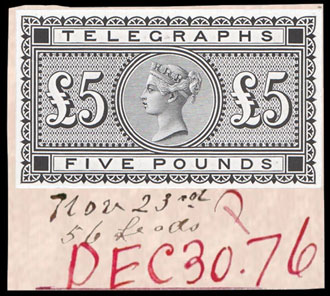
| Nov 23, 1876 | — | — | “Nov 23 / 56 Leads”, “P / Dec 30.76” | 0 + 1* |
* Langmead Collection — reconstruction.
In a Countersunk Frame
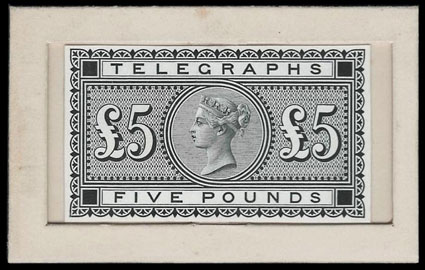
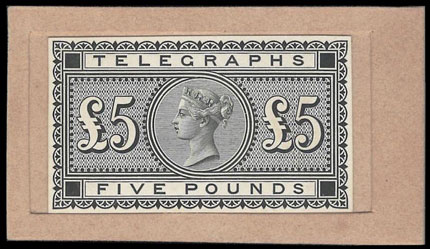
| no date | — | — | Cut down, set in a countersunk frame | 2 |
Sheet Layout
The sheet had 56 stamps in one large pane, arranged as 14 rows of four. Above and below the pane was “TELEGRAPHS FIVE POUNDS.”. Plate numbers were above DA and below AN, current numbers above AA and below DN. At the middle of the top was a vertical line, and at the middle of the bottom was a cross, used as guides for perforating. At the middle of each side was an arrow shaped division ornament.
10 shillings and above could be supplied singly to postmasters, there were no Post Office sheets.
Computer generated image, click to enlarge.
Plate Proofs
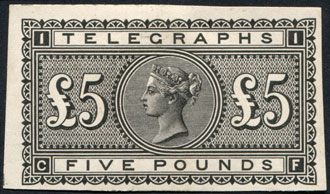
Plate proofs are known for plate 1. The reconstruction suggests there was a block of four and a single, or possibly two blocks of four since BM is in an usual position and unlikely to have been cut from the middle of the sheet. These are rare with only three examples known to us in private hands.
Red represents an institutionalised example.
Green a known example in private hands.
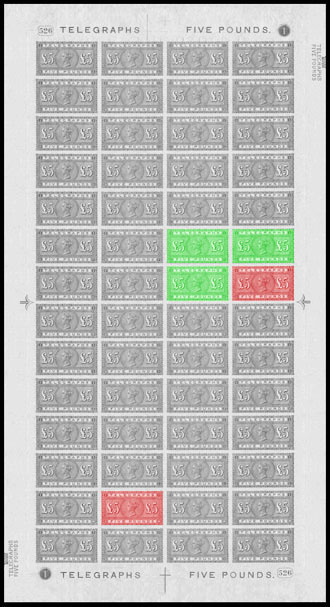
BM is in the Langmead Collection, DG in the Phillips Collection.
DF is illustrated in Wright and Creeke.
Paper
De La Rue used the paper they had in use for Irish dog license stamps, but this time in a vertical format. The £5 was printed on sheets rotated clockwise, each stamp having three, but more often parts of six, sideways-inverted shamrocks. However, the colour trials for the £5 and some Specimen Type 9 have a sideways watermark.
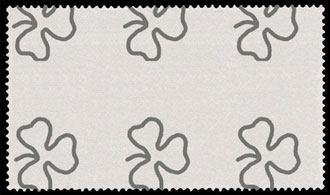
The watermark as seen from the front of the stamp.
For more details on Shamrock paper click here.
Colour Trials
For the second issue, colour trials were taken for all six values. They were dated “15 DEC 76”.
One sheet of the £5 was printed in gold but the cost estimate of 4d to 6d per stamp, or about £1 per sheet, ruled this out. The top half of the sheet is without overprint, the bottom half is overprinted with Specimen Type 11.
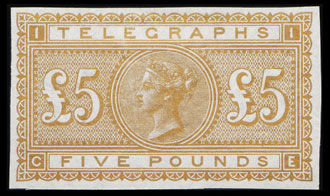
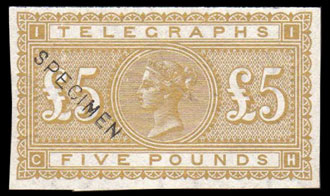
Trials were printed in six additional colours, one sheet of each, with a letter “A” through “F” written in the sheet margin next to the datestamp, below CN. Other blocks have had letters added, presumably added after they were cut from the sheet.
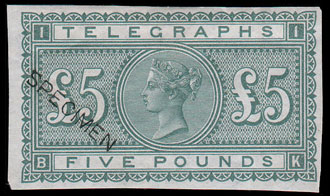
A: Grey-green
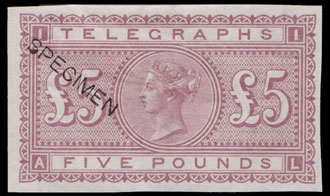
C: Dull Claret
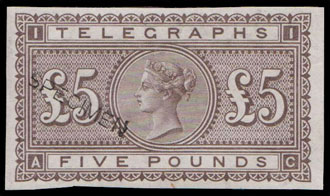
E: Brown-lilac
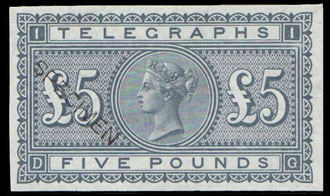
B: Slate-blue
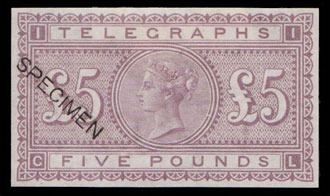
D: Dull Mauve
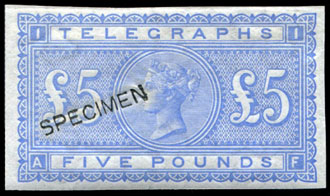
F: Pale Ultramarine
All are overprinted with Specimen Type 8 (top 10 rows diagonal up or down, bottom 4 rows diagonal down), except for the selected colour (F: Pale Ultramarine) which has three types of Specimen overprint all from the same sheet.
A: Grey-green
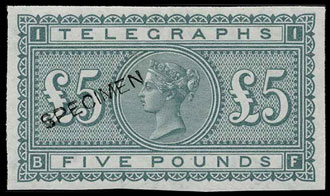

The colour varies considerably between examples and is easily confused with Slate-blue, but as the top 10 rows have the overprint sloping up for Grey-green and down for Slate-blue, only the bottom four rows present a challenge.
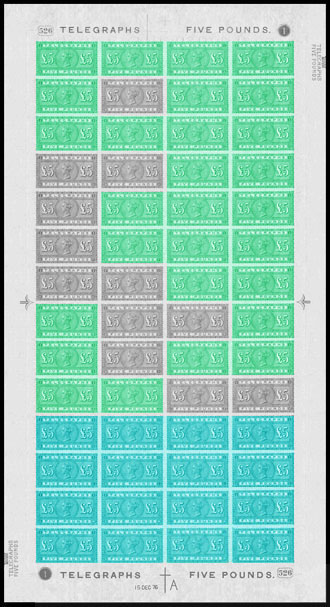
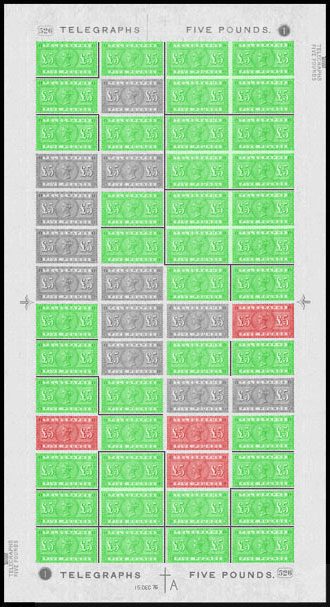
CK is in the Tapling Collection, CL in the Phillips Collection.
Three blocks of 4 and a pair still exist.
B: Slate-blue

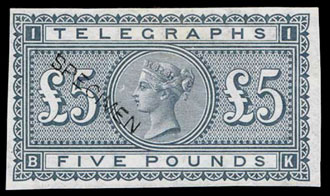
As with Grey-green, the colour varies considerably between examples and is easily confused with Grey-green, but as the top 10 rows have the overprint sloping up for Grey-green and down for Slate-blue, only the bottom four rows present a challenge. The colour is less blue than that of other values and might be better described as Slate, some examples being quite grey.
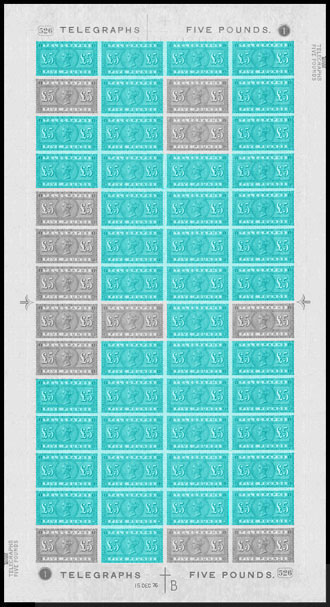
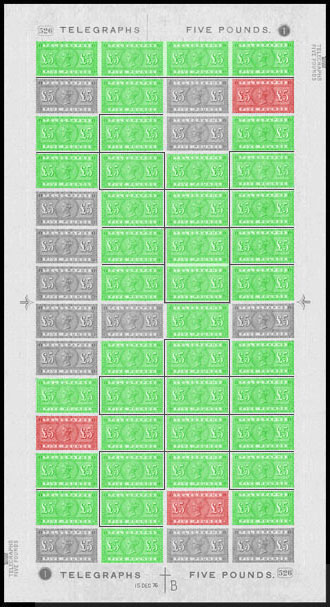
The top strip of 4 and a pair still exist.
BN has datestamp “15 Dec 76”.
C: Dull Claret
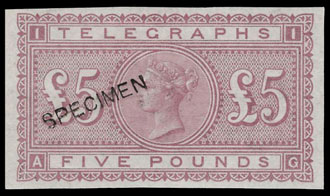

As with Grey-green and Slate-blue, Dull Claret and Dull Mauve are often confused but in this case the overprints all slope the same way and are of no help. The colours when seen in life are not too difficult to separate, but when looking at a scan or an auction catalogue it can be very difficult to distinguish. In these cases, we have used the margins to match adjacent examples but cannot be 100% sure of some, so there may be a small number misplaced. The large block of 20 helps, as other examples from the first five rows must be Dull Mauve.
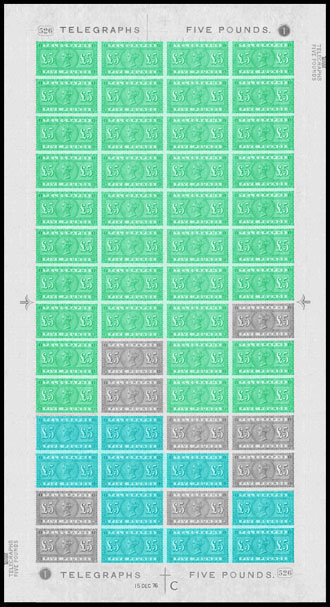
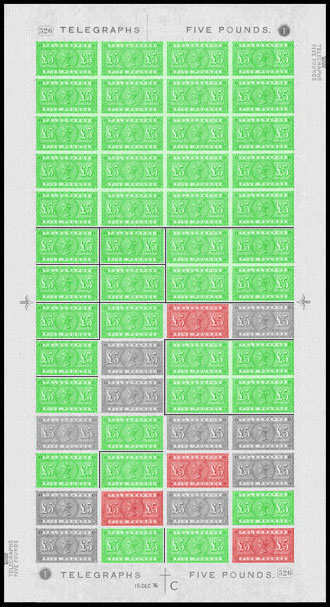
CL is in the Phillips Collection, DN in the Tapling Collection.
A block of 20 and two blocks of 4 still exist.
D: Dull Mauve
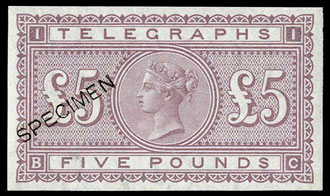

Often confused with Dull Claret, see the description of colour “C”.
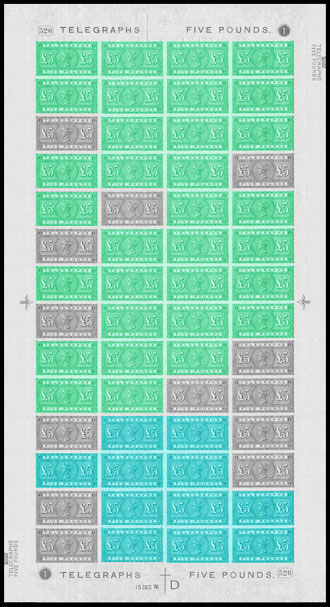
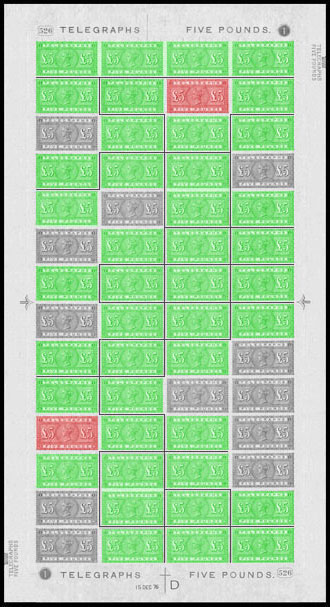
The top strip of 4 and two pairs still exist.
Pair CM-CN has recently been split, CN has manuscript “D”.
E: Brown-lilac

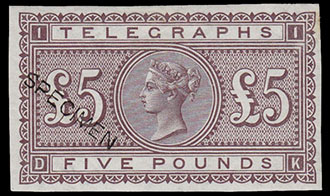
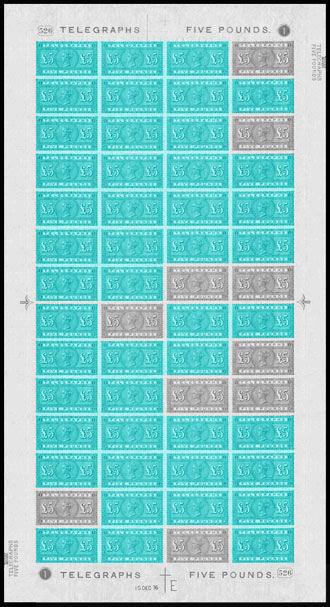
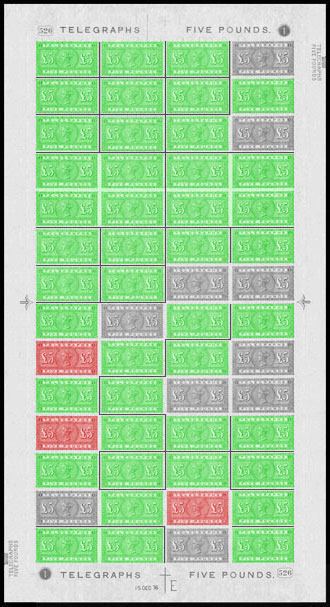
Two blocks of 4 and a plate number pair with datestamp still exist.
CH and DH have been badly perforated.
F: Pale Ultramarine (Selected Colour)

Type 8 diagonal up
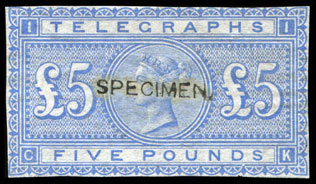
Type 8 horizontal
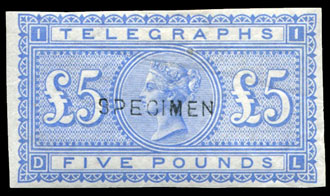
Type 11 horizontal
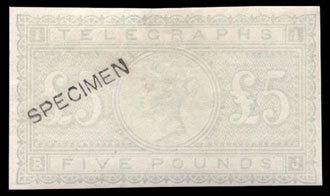
There are just two examples of Type 8 horizontal known to us: CK and DK.
BJ is heavily faded and has been sold in the past as Grey-green. However, the Grey-green example with this lettering exists, and reconstruction shows this example was Pale Ultramarine.
| Type 8: | Diag Down | Horizontal | Diag Up |
| Type 11: | Diag Down | Horizontal | Diag Up |
Green a known example in private hands.
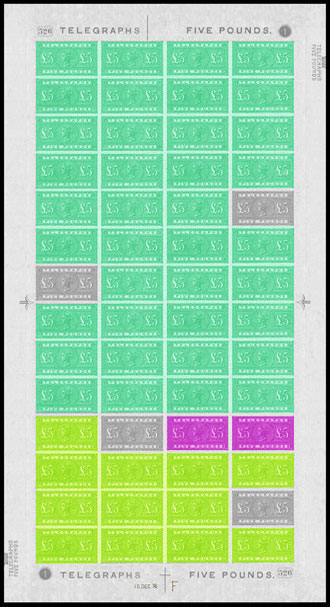
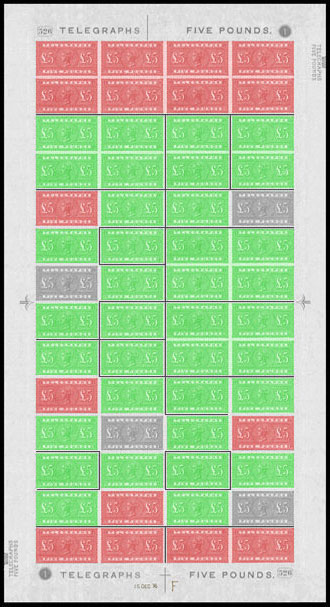
AJ in the Phillips Collection.
AN-BN and CN-DN are in the Royal Philatelic Collection with datestamp and manuscript “F”.
Three blocks of 4 and two additional pairs from a recently split block still exist.
G: Gold
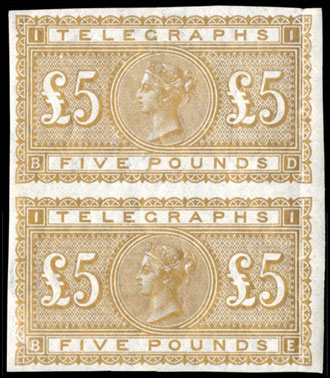
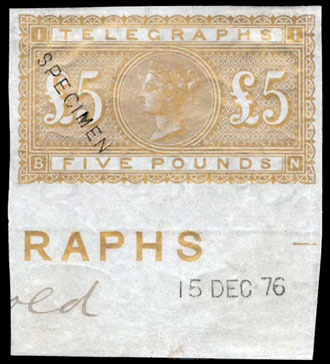
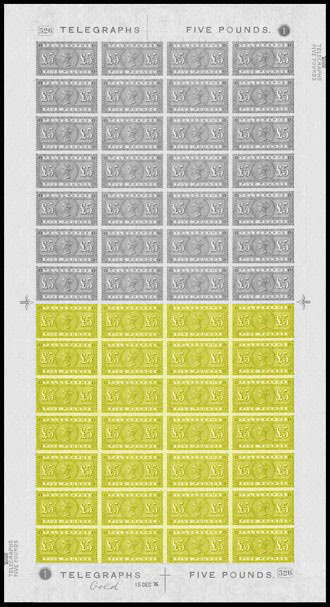
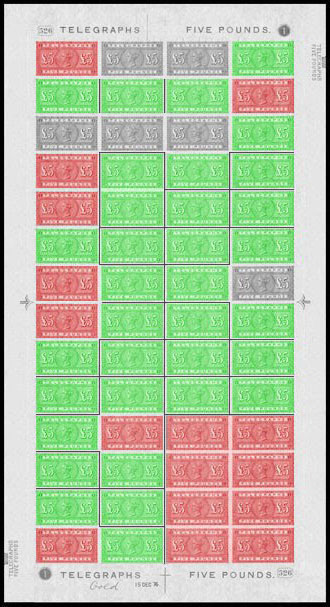
AE, AN, and DB are in the Royal Philatelic Collection.
AA is in the Tapling Collection, BK in the Phillips Collection, AG in the German Postal Museum.
One pair still exists: BD-BE.
BN has manuscript “(G)old” and datestamp “15 Dec 76”.
Colour Trial Images
Click the images to enlarge.
Imprimaturs
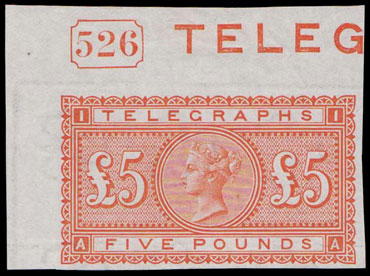
Plate 1 was registered on 17 Jan 1877.
Some imprimaturs have been perforated to look like mint stamps, sometimes poorly, often expertly. There are thus fewer imprimaturs known than expected, and more mint stamps known than expected. Mint stamps should be viewed with suspicion if from the imprimatur positions of the sheet.
The registration sheets for the Telegraphs have been lost. We can reconstruct them from known examples; however, the pattern that emerges for the high values is not as clear as that for the low values.
The low values generally have a column of 12 taken, plus four from the adjacent column, and a plate number example from the opposite corner. One sheet of each value has an extra column of 12 taken. The £5 fits this pattern if the first “column” of 12 is the top three rows, the extra 12 are the next three rows, the adjacent four is block AI-BJ, and the opposite corner is the bottom corner.
Red represents an institutionalised example.
Green a known example in private hands.
Blue is unknown but predicted by the pattern.
Orange is a known mint stamp.
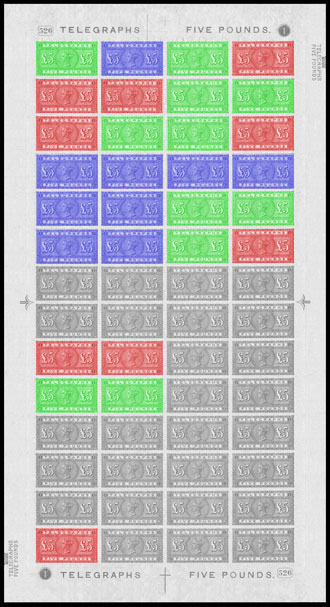
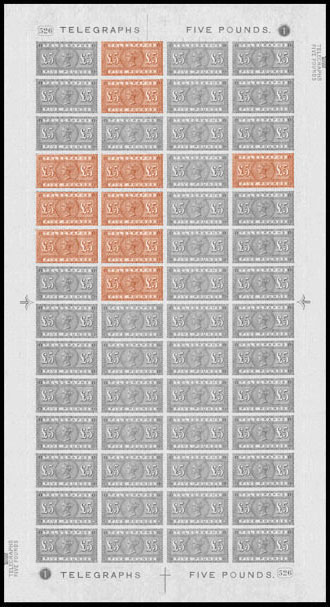
| Institutionalised/Total: | 9/29 |
| Royal Philatelic Collection: | AN, DA |
| British Postal Museum: | AI, BI |
| German Postal Museum: | BB |
| Tapling Collection: | AB |
| Langmead Collection: | AC |
| Phillips Collection: | DC, DF |
AA and AC are swapped in Langmead and Huggins:
AA is in private hands, AC in the Langmead Collection.
It can be seen that there are many unknown examples in this sheet reconstruction (in blue). Yet the expected number of imprimaturs together with the known examples predict that these should exist. Examining the known mint stamps (in orange in the adjacent image) suggests where they have gone.
Colour Standards
No colour standard sheet has been identified for the £5, but could be one of the perforated sheets overprinted Specimen Type 9 below.
Specimens
Type 8:
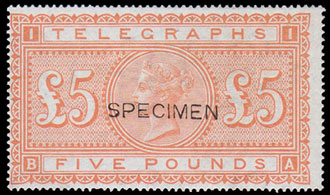
Plate 1 Type 8: scarce, from 6 quarter sheets (AA-BG x6), all singles, 42 known.
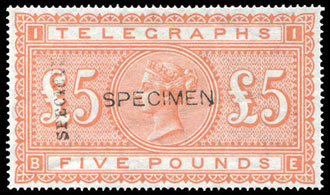
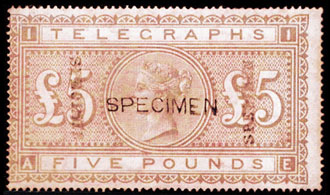
Plate 1 Type 8 and Type 9: rare, with Type 9 once vertical.
Plate 1 Type 8 and Type 9: rare, with Type 9 twice vertical (colourised).
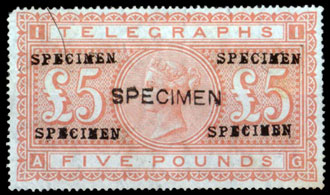
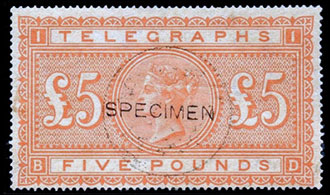
Plate 1 Type 8 and Type 9: rare, 4x horizontal, AG (illustrated) and BF (Langmead Collection).
Plate 1 Type 8: postmark applied, 1 known.
Type 9:
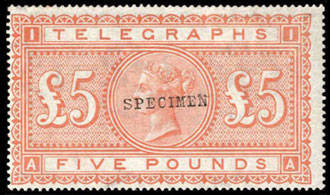
Plate 1 Type 9: scarce, from 7 quarter sheets (AA-BG x3, AH-BN x4), 53 known including: a block of 6, two blocks of 4, a pair, a few with watermark sideways, and 3 with postmark applied (see below).
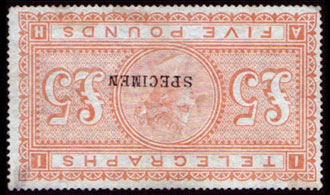
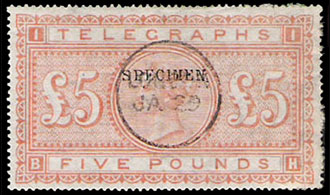
Plate 1 Type 9: watermark sideways (paper inverted), scarce, from two quarter sheets, AH-BN.
Plate 1 Type 9: postmark applied, 3 known.
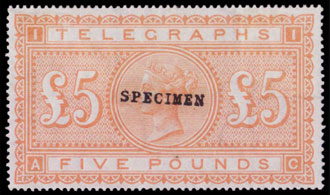
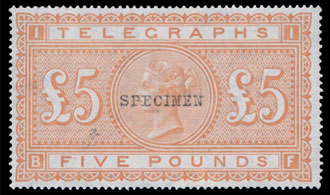
Plate 1 Type 9b: scarce, from 4 quarter sheets (CA-DG x4), all singles, 28 known.
Plate 1 Type 9c: rare, from 1 quarter sheet (AA-BG), all singles, 3 known.
Click the images to enlarge.
Type 11:
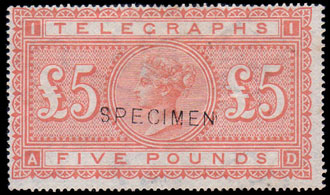
Plate 1 Type 11: scarce, from 4 quarter sheets (AA-BG x4), all singles, 28 known.
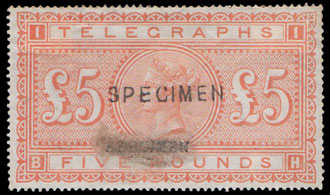
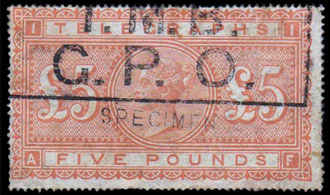
Plate 1 Type 11: with erased Type 9, possibly unique. BH from a different quarter sheet.
Plate 1 Type 11: TMB/GPO postmark applied (see below).
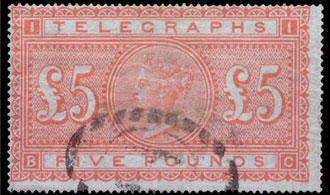
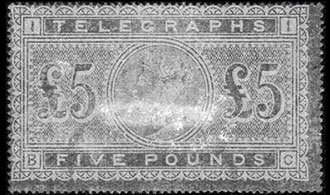
Plate 1 Type 11: with hidden overprint, doctored area shown by RetroReveal.
Reference to scarcity, blocks and the number of sheets or panes so treated is derived from reconstructions of known examples within our database.
Issued Stamps
Stamps were issued from plate 1 only.
The usage frequency graph shows that plate 1 was used across the whole period of the second issue.
Click the graph to enlarge.
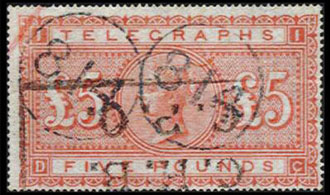
Postal, fiscal, and railway usage are rare, with only one 814 “English Station” railway numeral known to us.
Boxed Cancellations
Boxed cancellations are often found on high value telegraph stamps, the most common being TMB, with TAB and CHB being distant second and third. CMB and OPTB may not exist (perhaps CMB being a misread CHB on the stamp shown above, and OPTB from a double cancellation) and the others were likely issued after telegraph stamps were withdrawn. They were used by various branches of the Post Office for accounting purposes.
| C.H.B. / G.P.O. | Clearing House Branch |
| C.M.B. / G.P.O. | – may not exist |
| I.T.B. / G.P.O. | Inland Telegraph Branch |
| T.A.B. / G.P.O. | Telegraph Accounts Branch |
| T.C.B. / G.P.O. | Telegraph Clearing Branch |
| T.M.B. / G.P.O. | Telegraph Message Branch |
| O.P.T.B. / G.P.O. | – may not exist |
| P.A.B. / G.P.O. | Pay and Accounts Branch |
Issued Stamps — Plate 1
Plate 1 (current no. 526) was registered and put to press on 17 Jan 1877. 1,500 sheets were printed before telegraph stamps were discontinued and the plate was converted for use as the £5 postage stamp.
Some imprimaturs have been perforated to look like mint stamps, sometimes poorly, often expertly. There are thus fewer imprimaturs known than expected, and more mint stamps known than expected. Mint stamps should be viewed with suspicion if from the imprimatur positions of the sheet.
Scarcity #33 in mint telegraphs, #22 in used telegraphs.
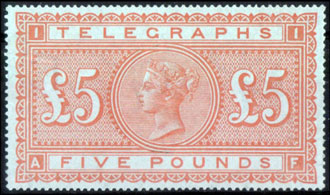
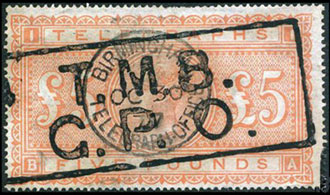
No mint multiples are known to us.
Used stamps are common, but only one used multiple is known to us, a strip of three AB-AD. Of the 202 examples in our database none are from the AH-BN quarter sheet, with the majority coming from the top half of the sheet. The earliest known used examples are 30 Oct 1877 at Birmingham Telegraph Office (illustrated) and at Liverpool Exchange. A third used in October may be earlier but the date is not readable, it was used at Gresham House B.O., E.C.
Inverted watermarks probably exist, but none have been seen by us.
Click the image to enlarge.
